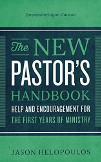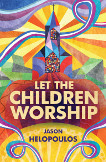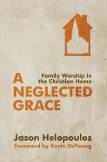
A Tale of Two Trees
When I was a new convert--having been brought from spiritual death to spiritual life--one of the things that I distinctly remember seeing with new eyes were trees. This was, in large part, because the Lord was enabling me to understand in all the Scriptures the redemptive-historical nature of trees from the Garden to the cross to the new creation. Little did I know then the depths of the theological significance of the two Adams (i.e. Adam and Christ) and the two trees (i.e. The Tree of the Knowledge of Good and Evil and the Cross) in Scripture.
From the earliest time in New Testament church history, the Tree of the Knowledge of Good and Evil and the Tree of Life have been viewed as the most significant elements of human history. There is, perhaps, no more helpful treatment of the trees of the Garden than that which is found in Geerhardus Vos’ Biblical Theology. Additionally, Sinclair Ferguson's observations on the two Adams and the two trees in his 2011 Ligonier National Conference lecture, "Why the God-Man?" --together with his further explanations in the Q & A section of that Conference--are some of the most worthwhile in helping us grow deeply in our understanding of this subject.
The Cross and the Knowledge of Good and Evil
When he first came to treat the subject of the Tree of the Knowledge of Good and Evil, Vos explained that the tree served a twofold purpose. First, it was meant to be a probation–to test Adam’s obedience to his Creator. Satan would turn the test into a temptation thus making it a temporary probation. Second, it was meant to give Adam the experiential knowledge of Good and Evil. If Adam obeyed he would have experientially learned evil from the prospect, and in contrast to, having chosen the good. If he disobeyed, he would experientially learn the evil by choosing the evil and rejecting the good. In this way, he would remember the good that he once knew in contrast with having chosen the evil. Vos explained what Adam would have gained had he passed this probationary test when he wrote the following:
Man was to attain something he had not attained before. He was to learn the good in its clear opposition to the evil, and the evil in its clear opposition to the good. Thus it will become plain how he could attain to this by taking either fork of the probation-choice. Had he stood, then the contrast between good and evil would have been vividly present to his mind: the good and evil he would have known from the new illumination his mind would have received through the crisis of temptation in which the two collided. On the other hand, had he fallen, then the contrast of evil with good would have even more vividly impressed itself upon him, because the remembered experience of choosing the evil and the continuous experience of doing the evil, in contrast with his memory of the good, would have shown most sharply how different the two are. The perception of difference in which the maturity consisted related to the one pivotal point, whether man would make his choice for the sake of God and of God alone...1
It is interesting to note that it was Satan’s purpose to lead man to believe that the tree had in itself a magical power of conferring knowledge of good and evil. Vos elsewhere noted (as did Calvin) that the two trees in the midst of the Garden were sacramental. It is important to see that Satan was, from the beginning, trying to get man to misunderstand the nature of a sacrament, and to look to them as the thing in itself, working, as it were, ex opere operato.
Adam did truly attain to the knowledge of good and evil; but, as Vos noted, he attained it from the standpoint of becoming evil and remembering the good in contrast to the evil he performed.
If we make Genesis 1-3 our starting point, and then consider all the occasions in which man is called to make judgments (i.e. to decided between good and evil) we soon discover that he will always choose the evil over the good in his natural state. When the LORD comes to assess Israel’s actions through the prophet Jeremiah this is what He concludes: ”For My people are foolish, they have not known Me. They are silly children, and they have no understanding. They are wise to do evil, But to do good they have no knowledge" (Jeremiah 4:22). A little later, the Lord says of Israel, “they proceed from evil to evil, And they do not know Me.” It is the knowledge of the LORD that men lack. This knowledge is the knowledge of good. There are many similar verses in the prophets in which the LORD brings the charge that all men by nature, including His people Israel, have not learned how to do good. We see the culmination of the Old Covenant Israelites evil ways when we approach the second tree of the knowledge of Good and Evil, namely, the cross on which our Lord Jesus died in our place.
On the night when our Lord was betrayed and brought before human judges, He was struck by one of the soldiers. Explaining that He "always taught openly," and that He "never said anything in secret," He was vindicated His uprightness. To the soldier that struck Him, Jesus replied, "If I have spoken evil, bear witness of the evil; but if good, why do you strike Me" (John 18:23)?
The knowledge of good and evil is always before us; and, it is evident, unregenerate men will inevitably and irrationally choose evil each and every time they make a decision. We must understand that Jesus is the Good, just as He is the Way, the Truth, and the Life. Everything that involves Jesus involves the Good and the True. But this is–more than anything else–what causes the evil in man’s heart to surface. There is no greater example of this than at the cross.
The cross becomes the “tree” (1 Peter 2:24) of the Knowledge of Good and Evil. At Calvary the Jews and Romans (representative of all men) make the ultimate decision for evil. In the face of their crying, “Crucify Him, crucify Him,” the Divine judge shows to a world blinded by evil, His verdict on that evil. But it is there that the One who did no evil was made sin for us, so that we might become the righteousness of God in Him. The words of Joseph never rang so loudly, “You meant it for evil, but God meant it for good” (Gen. 50:20).
The One who hung on the tree restores the knowledge of the Good--to all those who trust in Him--that Adam lost by choosing the evil. God has chosen to reverse, in His image bearers, all that Adam lost by means of the One who hung on this tree, even our Lord Jesus Christ. There is no other tree that so fully manifests the knowledge of good and evil. This is the final probation. What we do with God’s command concerning this tree is the only thing that matters now.
The Cross and The Tree of Life
But there is another way that we are to view the tree of the knowledge of Good and Evil in contrast with the other significant tree in redemptive-history. Adam, the son of God (Luke 3:38), forfeited our right to the Tree of Life by taking the fruit of the Tree of the Knowledge of Good and Evil. Christ, the second Adam, gives us access to the Tree of Life by hanging on the cursed tree. Sinclair Ferguson so helpfully explains the relationship between the first Adam--and the Tree from which he ate--and the second Adam--and the Tree from which He ate (spiritually)--when he said:
What was the nature of Jesus' temptation in the Garden that made Him say, "Let this cup pass from Me--that's My desire"? That was a perfectly holy desire. Any other desire would have been an unholy and godless desire. Why? Because a holy man can never have any wish or desire or purpose to experience a sense of divine desolation. It was not within our Lord Jesus' holy humanity to ever desire to be in a position where He would cry out, "My God, I am forsaken by You. Why?" The holiness of the soul of Jesus in the Garden of Gethsemane was compelled to say to the Father, "Not that tree;" and in doing so He was undoing what Adam and Eve, in the Garden of Eden, did--because the tree in the Garden of Eden is described in exactly the same terms as any other tree--there's no other difference. If you had walked past that tree there was no crooked branches saying, "I'm ugly; don't touch me." There would have been nothing about the fruit saying "I'm horrible; don't eat me." Just read the opening of Genesis 3 you'll see that tree is described in terms of its nature exactly the same way as every other tree is described.
So there was nothing in that tree itself that make Adam say, "Oh, I don't want that tree." What Adam was called to do was to say, "There is no reason in that tree itself for me to say I do not want it--except God has said, "Don't touch it." And so, at this point, I have to bow before God and say, "I trust you" even though everything in me says, "That tree looks absolutely delicious." That's actually obvious because God would not deceive a human being by making a tree that looked delicious and yet tasted poisonous...And so, as it were, on the other end of this strange spectrum of human history Jesus is facing another tree, and everything about that tree--in contrast with the tree in the Garden of Eden--is saying "You do not want me," and His Father is saying, "That's the tree whose fruit I want you to eat, and to do it simply because I'm Your Father, and I'm commanding You to save men and women in this way--So Jesus, take the cup." And the wonder of it all is (and Hebrews goes on to speak about those loud cryings and tears), is that He took the bitter fruit of Calvary's tree and consumed its last bitter dregs. That's why Paul said, "He became obedient to the point of death, even the death of the cross.2
Ferguson continues to develop this in the following way:
The New Testament doesn't make much of the fact that there is a connectedness between the tree in the Garden of Eden and the tree on which Christ was crucified except that we do have Man coming to the tree and the curse falling upon Him because of what happens at the tree; and then there is, inbuilt into the Old Testament law, that the man who hangs on a tree is accursed of God--and Paul picks that up...in Galatians 3:13 to say quite specifically "It's not accidental that Jesus was not stoned to death." There is a huge divine significance in the manner in which He died. That's another exposition of why it is that He dies by crucifixion and not by any other way... That parallel then is rooted in the notion of Paul in Romans 5:12-21--I think it lies behind Philippians 2:5-11--that the first Adam is disobedient; the second Adam is obedient. The first Adam grasps at equality with God; the second Adam who possesses equality with God doesn't count it a thing to be made a special consideration for Himself but humbles Himself, takes the form of a servant--being found in human form--He dies, and not just dies, but specifically dies the death of the cross.3
The Purtian, Thomas Watson, summed up the whole matter by drawing a contrast between Adam "taking and eating" from the tree of which he was commanded not to eat, and Christ "taking and eating" from the tree of which he was commanded to eat. Christ now commands His people to "take and eat" from this tree in the institution of the Supper. The cross is, in the truest sense of the word, "The Tree of Life" for those who eat of its fruit. Christ has caused the fruit of life to be born that we might experientially learn the knowledge of Good and Evil by choosing the good (i.e. Christ) and rejecting the evil. May we all do so by faith so that we may know the reversal of all that the first Adam brought upon us by taking from the tree of which God commanded him not to eat, and that we might know the blessing of now being able to take and eat of the Tree of Life.
1. Vos, Geerhardus Biblical Theology (1948), pp. 27-33.
2. Sinclair Ferguson "Why the God-Man?" from the 2011 Ligonier Ministries National Conference (at he 53:33 mark).
3. Ferguson "Q & A" from 2011 Ligonier Ministries National Conference (beginning at the 31:34 mark).
Nick Batzig is the church planter of New Covenant Presbyterian Church in Richmond Hill, Ga. He has written numerous articles for Tabletalk Magazine, Reformation 21, and is published in Jonathan Edwards and Scotland (Dunedin, 2011). Nick is also a regular panelists on Christ the Center, a podcast of The Reformed Forum, the host of East of Eden: The Biblical and Systematic Theology of Jonathan Edwards and the editor of the Christward Collective. You can find him on Facebook here or on Twitter @nick_Batzig.



















 © Alliance of Confessing Evangelicals
© Alliance of Confessing Evangelicals


